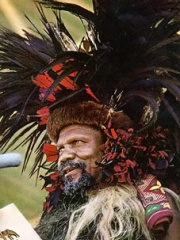

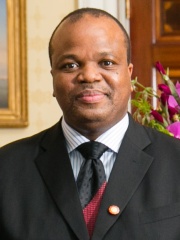
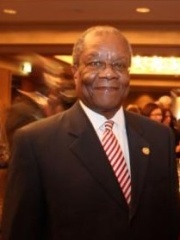

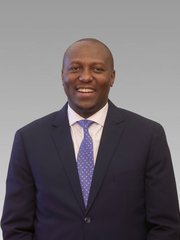
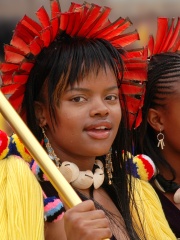
The Most Famous
POLITICIANS from Eswatini
This page contains a list of the greatest Swazi Politicians. The pantheon dataset contains 19,576 Politicians, 8 of which were born in Eswatini. This makes Eswatini the birth place of the 171st most number of Politicians behind Malawi, and Palau.
Top 8
The following people are considered by Pantheon to be the most legendary Swazi Politicians of all time. This list of famous Swazi Politicians is sorted by HPI (Historical Popularity Index), a metric that aggregates information on a biography's online popularity.

1. Sobhuza II (1899 - 1982)
With an HPI of 67.23, Sobhuza II is the most famous Swazi Politician. His biography has been translated into 42 different languages on wikipedia.
Sobhuza II (Swazi: [sɔbʱuzʱa]; also known as Nkhotfotjeni, Mona; 22 July 1899 – 21 August 1982) was Ngwenyama (King) of Swaziland (now Eswatini) for 82 years and 254 days, the longest verifiable reign of any monarch in recorded history. Sobhuza was born on 22 July 1899 at Zombodze Royal Residence, the son of Inkhosikati Lomawa Ndwandwe and King Ngwane V. When he was only four months old, his father died suddenly while dancing incwala. Sobhuza was chosen king soon after that and his grandmother Labotsibeni and his uncle Prince Malunge led the Swazi nation until his maturity in 1921. Sobhuza was acknowledged as King by the British in 1967, and Swaziland achieved independence in 1968. Sobhuza continued to reign until his death in 1982. He was succeeded by Mswati III, his young son with Inkhosikati Ntfombi Tfwala, who was crowned in 1986.

2. Ntfombi of Eswatini (b. 1950)
With an HPI of 66.87, Ntfombi of Eswatini is the 2nd most famous Swazi Politician. Her biography has been translated into 23 different languages.
Ntfombi Tfwala (also spelled Ntombi, born 27 December 1949) is Ndlovukati (Queen Mother) of Eswatini since 1983, as the mother and co-ruler of King Mswati III. She was also queen regent of Eswatini from 1983 until her son's accession in 1986.

3. Mswati III (b. 1968)
With an HPI of 64.07, Mswati III is the 3rd most famous Swazi Politician. His biography has been translated into 76 different languages.
Mswati III (born Makhosetive Dlamini; 19 April 1968) is the Ngwenyama (King) of Eswatini and head of the Swazi royal family. He heads an absolute monarchy, as he has unrestricted political authority and veto power over all branches of government and is constitutionally immune from prosecution. Along with his mother Queen Ntfombi, Mswati is the last remaining absolute monarch in Africa and one of the only twelve remaining absolute national or subnational monarchs in the world. Under the constitution, the king is the commander-in-chief of the defence force and commissioner-in-chief of police and correctional services, and Mswati effectively controls local governance through his influence over traditional chiefs. Political dissent and civic and labor activism in Eswatini are subject to harsh punishment under laws against sedition and other laws. In 2018, Mswati promulgated a decree renaming the country to Eswatini, from its previous name of Swaziland. Pro-democracy protests from 2021 onwards have been violently dispersed and political activists have been arrested. Mswati lives an opulent and lavish lifestyle which stands in sharp contrast to the lives of most Emaswazi people. In 2022, an estimated 32% of the population lived below the US$2.15/day international poverty line (measured by price-purchasing parity (PPP) in 2017) while 55% of the population was under the lower-middle-income country poverty line of $3.65/day. The government exercises total control over the broadcast media, including the only privately owned TV channel, which belongs to the royal family. Almost all media outlets are either directly or indirectly controlled by Mswati III.

4. Barnabas Sibusiso Dlamini (1942 - 2018)
With an HPI of 60.58, Barnabas Sibusiso Dlamini is the 4th most famous Swazi Politician. His biography has been translated into 28 different languages.
Prince Barnabas Sibusiso Dlamini (15 May 1942 – 28 September 2018) was a Swazi politician who served as Prime Minister of Eswatini, from 1996 to 2003 and again from October 2008 to September 2018.
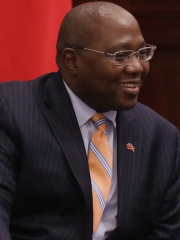
5. Ambrose Mandvulo Dlamini (1968 - 2020)
With an HPI of 57.86, Ambrose Mandvulo Dlamini is the 5th most famous Swazi Politician. His biography has been translated into 30 different languages.
Ambrose Mandvulo Dlamini (15 March 1968 – 13 December 2020) was a Swazi business executive who served as the tenth prime minister of Eswatini, holding the office from October 2018 until his death on 13 December 2020. Born in Eswatini's Manzini Region, Dlamini completed his degree at the University of Swaziland and an MBA at Hampton University, going on to work in the banking and telecommunications sectors. His career of more than 18 years in these sectors included positions as managing director of Nedbank and as CEO of MTN Eswatini. Following the death of Prime Minister Barnabas Sibusiso Dlamini in 2018, Dlamini was selected by King Mswati III to succeed him. He was the youngest prime minister in the country's history, and had no prior government experience. His work in government included cutting of nonessential expenses and making plans to improve the country's economy and ease of doing business ranking. He was also the head of the country's AIDS council.

6. Sotsha Dlamini (1940 - 2017)
With an HPI of 54.76, Sotsha Dlamini is the 6th most famous Swazi Politician. His biography has been translated into 18 different languages.
Prince Sotsha Ernest Dlamini (27 May 1940 – 7 February 2017) was Prime Minister of Swaziland from 6 October 1986 to 12 July 1989. He was born in Mankayane. Dlamini died on 7 February 2017, aged 76.

7. Russell Dlamini (b. 1973)
With an HPI of 48.75, Russell Dlamini is the 7th most famous Swazi Politician. His biography has been translated into 19 different languages.
Russell Mmiso Dlamini (born 23 October 1973) is a Liswati politician. He has been serving as Prime Minister of Eswatini since 7 November 2023.

8. Sikhanyiso Dlamini (b. 1987)
With an HPI of 41.71, Sikhanyiso Dlamini is the 8th most famous Swazi Politician. Her biography has been translated into 21 different languages.
Princess Sikhanyiso Dlamini (Swazi: [sikʰaɲiso ɮʱamini]; born 1 September 1987) is a Swazi princess and politician. She is the eldest daughter of King Mswati III of Eswatini, and is the country's former Minister of Information and Communication Technology.
People
Pantheon has 8 people classified as Swazi politicians born between 1899 and 1987. Of these 8, 4 (50.00%) of them are still alive today. The most famous living Swazi politicians include Ntfombi of Eswatini, Mswati III, and Russell Dlamini. The most famous deceased Swazi politicians include Sobhuza II, Barnabas Sibusiso Dlamini, and Ambrose Mandvulo Dlamini. As of April 2024, 1 new Swazi politicians have been added to Pantheon including Russell Dlamini.
Living Swazi Politicians
Go to all RankingsNtfombi of Eswatini
1950 - Present
HPI: 66.87
Mswati III
1968 - Present
HPI: 64.07
Russell Dlamini
1973 - Present
HPI: 48.75
Sikhanyiso Dlamini
1987 - Present
HPI: 41.71
Deceased Swazi Politicians
Go to all RankingsSobhuza II
1899 - 1982
HPI: 67.23
Barnabas Sibusiso Dlamini
1942 - 2018
HPI: 60.58
Ambrose Mandvulo Dlamini
1968 - 2020
HPI: 57.86
Sotsha Dlamini
1940 - 2017
HPI: 54.76
Newly Added Swazi Politicians (2025)
Go to all RankingsOverlapping Lives
Which Politicians were alive at the same time? This visualization shows the lifespans of the 4 most globally memorable Politicians since 1700.

